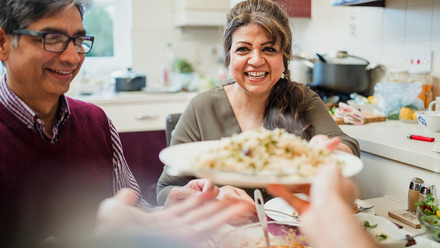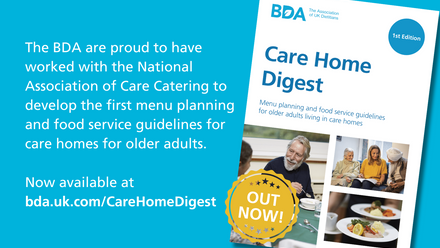Dr Nina McGrath, Senior Manager for Food Safety at the European Food Information Council (EUFIC), provides key facts and information on food safety as well as some basic safe food handling tips.
What is food safety?
It’s estimated that in the UK, around a million people experience a foodborne illness every year. Food can become unsafe when it is contaminated with illnesscausing bacteria, viruses, parasites or chemicals. Symptoms range from mild to severe, but commonly include nausea, vomiting, diarrhoea, stomach cramps, weakness, fever and chills. In severe cases, foodborne illness can lead to hospitalisation or even death.
Food can become contaminated at any stage of production, processing, distribution, storage or preparation. For example, germs can spread to food from unclean surfaces, utensils or equipment that are used whether during food production or at home in our own kitchen. If chilled raw foods like meat or dairy products are left at room temperature for too long, for example during transport to or from the supermarket, bacteria can grow faster than expected and pose a safety risk.
The term ‘food safety’ describes all practices that are used to keep our food safe. Food safety relies on the joint efforts of everyone involved in our food supply. All along the food chain, from farmers and producers to retailers and caterers, legislation and controls are in place to reduce the risk of contamination, and personally we each have a role to play as well.
Do we take safe food for granted?
A recent survey found that in the UK, people now spend more than five hours a week consuming food-related media on television, in books and online. Despite this, food safety is often overlooked. For example, television cooking shows rarely show celebrity chefs following basic safe food handling rules, like handwashing (although they may of course be doing it off-camera!)
Added to this, recent food trends have focused around the perceived superiority and healthfulness of unprocessed or ‘natural’ foods. While fresh
foods undoubtedly have a major role to play in a healthy diet, these trends may lead to a tendency to underestimate the benefits that processing techniques like canning, pasteurisation or freezing can provide in terms of safety and shelf-life. For example, tinned vegetables stay safe to eat for years, and are a convenient and affordable way to add vegetables to your diet.
Trends like these are of particular concern when they lead to risky food choices, for example in the case of raw milk products. Raw milk is becoming more popular despite the fact that it has been linked to outbreaks of Salmonella, Campylobacter, and Listeria, and caused cases of severe illness. On the other hand, the process of pasteurisation (heating for short periods of time to kill bacteria), is simple, cheap and very effective at eliminating these microbes, while having little effect on the nutritional value of milk.
What about packaging?
Food packaging plays an important role as a physical barrier to protect food from damage, contamination and tampering during transport and storage. Many foods also need protection from moisture, air or light to keep them fresh and safe to eat for longer, and even simple packaging materials like glass, plastics and paper can do a lot to improve safety and extend shelf-life.
However, every year millions of tonnes of packaging ends up as plastic pollution in our environment, seas and oceans. As a result, research is now shifting towards developing new sustainable food packaging materials that are recyclable or biodegradable to help limit the impact of food packaging waste. For example, by-products from food processing (like cheese whey or potato juice) are being used to develop fully biodegradable packages. We may also see edible coatings, made from ingredients like milk protein or corn, applied directly to some food products, removing the need for packaging at all.
Cut waste, without taking risks
Globally, we waste around one third of all food produced. The good news is that more and more people and businesses are becoming aware of the problem and taking steps to reduce waste. A great place to start is to pay attention to date labels:
- Use-by dates are usually found on perishable foods such as meat, dairy, and ready-meals and tell us until when we can safely eat the food. After this date, it may not be safe. Check what’s in your fridge regularly and use up foods nearing their use-by date, or freeze them for later.
- Best before dates are more flexible. Foods like dried beans, lentils, and pasta are still safe to eat after this date, but you may notice changes in flavour, colour or texture. Trust your senses!
Take control!
In the UK, many people get sick from their food at home, and bacteria (such as Campylobacter and Salmonella) and viruses (such as norovirus) are common causes. Sticking to some basic safe food handling tips can help us avoid getting sick.
1. Keep clean
Microbes spread to food through physical contact, for example from your hands or cooking utensils.
- Always wash your hands thoroughly with warm soapy water before handling food, and repeat often while cooking.
- Prepare and chop food on a clean surface and clean all utensils and surfaces thoroughly after use with hot water and detergent, or in the dishwasher.
- Wash dishcloths, tea towels, and aprons frequently at high temperatures.
2. Seperate raw and cooked
Raw foods like meat, fish and poultry are most likely to contain illness-causing microbes. These can be transferred to ready-to-eat foods by cross-contamination directly (for example if raw meat touches cooked foods) or indirectly (for example chopping salad vegetables with a knife that was used to chop raw meat). To avoid cross-contamination:
- Use different coloured chopping boards to fruit and vegetables, fish, meat, poultry and cooked foods, so you always know which to use.
- Use separate re-usable shopping bags for raw and ready-to-eat foods and label them so you remember which is which!
3. Cook thoroughly
Cooking and heating foods to temperatures until piping hot throughout will kill most illness-causing microbes. The most reliable way to check the temperature is to use a cooking thermometer - check that your food has reached a core temperature of least 72 degrees C for 2 minutes.
- Whole cuts of beef or lamb can be eaten rare or pink as they are unlikely to have harmful bacteria in the centre. The outer surface should be seared.
- For pork and poultry, there should be no pink meat left. If you don’t have a thermometer, pierce the thickest part with a fork or skewer; the juices should run clear, not pink.
- Ground meat and fish products like burgers, sausages or fishcakes should be cooked thoroughly all the way through.
- Reheat leftovers thoroughly all the way through. Bring soups and stews to the boil for at least 2 minutes.
4. Store at safe temperature
Not all foods need to be refrigerated. Clean, dry and cool shelves are the best place to store bread, dry food (in sealed bags or containers), unopened tins and jars.
Foods like milk, meat, fish, poultry, and our own meal leftovers should be kept in the fridge, to slow down the growth of harmful microbes.
- Remember the ‘2-hour rule’: whether it is leftover, take-away, or just-bought, cool and place foods in the fridge within 2 hours.
- Keep the fridge below 5 degrees C - check regularly with a fridge thermometer.
- Store raw meat, fish and poultry in sealed containers, on the bottom shelf of your fridge to avoid spread of germs to ready-to-eat foods.
- When transporting food (for example, taking your lunch to work) use an insulated bag or cold box with ice pack (or a carton of frozen juice!) to keep your meal at a safe temperature.







